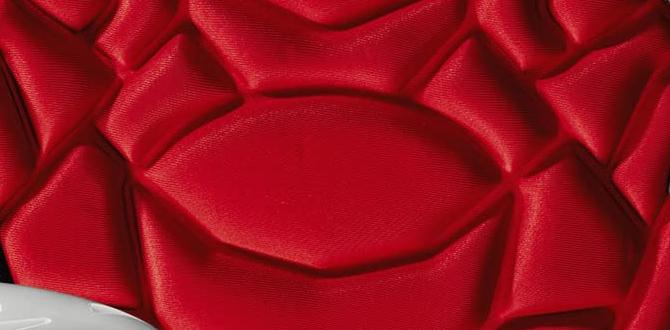Essential shelves for stereo equipment provide stable, organized storage, protecting your gear and enhancing your listening experience. Find smart, simple solutions perfect for any setup.
Shelves for Stereo Equipment: Essential, Genius Solutions
Got a pile of audio gear looking a bit… messy? You’re not alone! Many of us start with a few great pieces of stereo equipment, and before we know it, they’re stacked precariously or taking over the living room. This can not only look untidy but can also lead to overheating or damage for your precious electronics. Don’t worry, finding the right shelves for your stereo equipment doesn’t have to be complicated. We’ll walk you through everything you need to know to create a functional, stylish, and safe home for your sound system.
We’ll cover the different types of shelves available, what to look for when choosing, and how to set them up for the best results. Get ready to transform your audio setup from a jumbled mess to a well-organized, great-sounding sanctuary!
Why Proper Shelving Matters for Your Stereo Equipment
Think of your stereo components like athletes on a playing field. They need room to breathe, a stable foundation, and protection. Improper storage can lead to some serious problems:
- Overheating: Many components, like amplifiers and receivers, generate heat during operation. If they’re crammed together or have no ventilation, that heat can build up, shorten their lifespan, and even cause component failure.
- Vibrations: Speakers, especially, can create vibrations. If your turntable or CD player is sitting on the same surface or shelf as a vibrating speaker, it can introduce noise and distortion into your music.
- Damage: Accidental bumps, spills, or scratches can easily happen in a cluttered space. Good shelving helps keep everything secure and protected.
- Aesthetics: Let’s face it, neatly organized equipment just looks better! Proper shelving makes your stereo system a statement piece, not an eyesore.
- Accessibility: When everything has its place, it’s easy to access different components, swap out cables, or perform basic maintenance.
Types of Shelves for Your Stereo Equipment
There’s a shelving solution for every need and budget. Let’s break down the most popular options:
1. Dedicated Audio/Component Racks
These are often the gold standard for audiophiles. They’re designed specifically to house stereo equipment, offering:
- Isolation: Many feature isolation spikes or dampening materials to minimize vibrations.
- Ventilation: Open designs ensure excellent airflow.
- Modularity: You can often add or rearrange shelves as your system grows.
- Strength: Built to hold heavy components like turntables and receivers.
These can range from simple, multi-tier metal racks to elaborate wooden structures. They’re an investment, but they offer the best performance and protection.
2. Wall-Mounted Shelves
A fantastic space-saving option, especially for smaller rooms or if you want to keep your equipment off the floor. Wall-mounted shelves come in various styles:
- Floating Shelves: These give a minimalist “floating” look, with no visible brackets. They’re great for lighter components like streamers or DACs, but ensure you use heavy-duty anchors for anything substantial.
- Bracketed Shelves: More common and versatile, these use visible L-shaped brackets. They can support heavier loads and are generally easier to install.
- Purpose-Built Media Shelves: Some wall shelves are designed with cable management and ventilation in mind, specifically for A/V equipment.
Important Note: Always ensure you are mounting shelves into wall studs or using appropriate heavy-duty drywall anchors for safety. Consult resources like This Old House’s guide on finding wall studs for proper installation techniques.
3. Bookshelves and Entertainment Units
If you’re on a tighter budget or prefer a more integrated look, a sturdy bookshelf or a TV stand with built-in shelving can work. Key considerations here are:
- Depth: Ensure the shelves are deep enough to accommodate your components without them hanging over the edge.
- Height: Consider the vertical space needed for taller components like receivers.
- Sturdiness: Look for solid construction that won’t bow under weight.
- Ventilation: You might need to drill extra holes for airflow or ensure there’s ample space around components.
These often offer a cozier, more integrated feel within a living space.
4. Modular Storage Systems
Brands offer modular cube cubes or shelving units (like IKEA’s Kallax or custom solutions) that can be configured to your needs. You can:
- Mix and Match: Combine open cubes for larger gear with drawer or door modules for accessories.
- Expand Later: Easily add more units as your collection grows.
- Customize: Some offer back panels, doors, and inserts for a personalized look.
5. Speaker Stands
While technically for speakers, good speaker stands are crucial for optimizing sound quality and can help with overall system organization. They ensure speakers are at the correct listening height and decouple them from the floor, reducing vibrations.
What to Look for When Choosing Shelves
Beyond the type of shelf, several factors will help you make the best choice:
A. Material and Construction
- Wood (Solid & Veneered): Offers a classic look and good vibration damping. Solid wood is premium, while veneer over MDF or particleboard is more budget-friendly. Ensure it’s thick and well-constructed.
- Metal: Often used for component racks. Steel is strong and durable, while aluminum is lighter. Powder-coated finishes resist scratches. Metal can sometimes resonate, so look for designs with dampening features.
- Glass: Tempered glass is safe and can look sleek, especially for modern setups. It can, however, transmit vibrations more readily than wood or dense composites, so isolation is key.
- MDF/Particleboard: Common in furniture. Look for thicker, denser options that can support weight without bowing. Avoid flimsy materials.
B. Weight Capacity
This is paramount! Amplifiers and receivers can be surprisingly heavy. Check the manufacturer’s specifications for the maximum weight each shelf can safely hold. Don’t guess; it’s better to over-spec and be safe. A general guideline for component racks is that each shelf should hold at least 30-50 lbs (13-23 kg), but high-end components can easily exceed this.
C. Dimensions and Clearance
- Depth: Ensure the shelf is deeper than your longest component (usually the receiver or amplifier). Add a few inches for cable connectors and airflow.
- Width: Will your components fit side-by-side if needed? Or are you placing them one behind another?
- Height: Crucially, measure the height of your tallest component (e.g., a receiver) and add space for ventilation. A component shoved tight against the shelf above it will overheat. Aim for at least 3-4 inches (7-10 cm) of clearance above components that generate significant heat.
D. Ventilation and Airflow
As mentioned, this is critical. Open-back designs or shelves with significant space around components are best. Some racks have small fans, but for most home systems, intelligent placement and open shelving are sufficient. Avoid enclosed cabinets unless they are specifically designed with robust ventilation systems.
E. Stability and Vibration Damping
- Leveling Feet: Adjustable feet allow you to level the unit, ensuring stability and reducing the risk of tipping.
- Isolation: Look for shelves with built-in vibration-damping features like rubber pads, isolation cones, or composite materials. If not, you can often add aftermarket solutions.
- Solid Construction: A heavy, well-built unit will inherently be more stable and less prone to vibrations than a flimsy one.
F. Cable Management
Tangled wires can ruin the look of even the most advanced system. Look for shelves with:
- Cable Gaps: Spaces in the back or between shelves for routing cables.
- Cable Management Clips/Ties: Some units include these, or they are easy to add.
- Integrated Channels: Higher-end racks might have built-in channels for a very clean look.
Best Practices for Installing and Arranging Your Stereo Equipment Shelves
Once you’ve picked out your shelves, it’s time to set them up. Here’s how to do it right:
Step-by-Step Installation Guide (General)**
This guide is general; always follow the manufacturer’s specific instructions.
- Gather Tools: You might need a stud finder, level, drill, screwdriver set, measuring tape, and possibly safety glasses.
- Read Instructions: Seriously, take a few minutes to read the manual that came with your shelves.
- Locate Studs (for wall-mounting): Use a stud finder to locate wall studs for maximum support when mounting shelves. Mark the stud locations.
- Mark Shelf Placement: Decide where you want your shelves. Use a level to ensure your marks are straight. For wall-mounted shelves, mark where the brackets will attach.
- Pre-drill Holes: If mounting into studs, pre-drill pilot holes slightly smaller than your screws. If using drywall anchors, follow the anchor’s instructions for hole size.
- Assemble Frame (if applicable): For component racks or modular units, assemble the frame according to the instructions. This often involves connecting uprights with shelves.
- Mount Brackets (for wall-mounting): Attach the brackets to the wall, ensuring they are level and securely fastened into studs or anchors.
- Install Shelves: Slide shelves into place on the rack or attach them to the wall brackets.
- Secure Everything: Tighten all screws and ensure the unit is stable and level.
- Test Stability: Gently push on the shelves to ensure they are secure and don’t wobble.
Arranging Your Equipment for Optimal Performance
Placement matters for both sound and component health. A common setup hierarchy is:
- Bottom Shelf: Often the sturdiest and best for heavier items like a receiver or subwoofer.
- Middle Shelves: Ideal for source components like CD players, turntables, or streamers.
- Spaced Out: Don’t cram components together. Leave space between them for heat dissipation.
- Turntable Placement: Keep turntables away from speakers if possible. Vibration is the enemy of good vinyl playback. Some audiophiles even use separate, dedicated stands for their turntables.
- Power Conditioning: If you use a power conditioner, it’s often good to place it near the power outlet and have your components plugged into it.
Dealing with Vibrations
If you notice buzzes or rattles, or if your vinyl skips:
- Isolation Pads: Place dense rubber or sorbothane pads under speakers and even under components that are sensitive to vibration (like turntables).
- Speaker Stands: Use sturdy, filled speaker stands if appropriate for your speaker type to decouple them from the floor.
- Check Component Placement: Ensure no component is directly touching a vibrating speaker.
- Tighten Everything: Loose screws can cause rattles.
Popular Shelf Materials: Pros and Cons
Let’s look at the common materials you’ll encounter.
| Material | Pros | Cons |
|---|---|---|
| Solid Wood | Excellent vibration damping, beautiful aesthetic, very durable. | Expensive, can be heavy, susceptible to humidity changes. |
| Wood Veneer (on MDF/Particleboard) | Looks like solid wood, more affordable, good stiffness. | Veneer can chip or peel, MDF can swell if exposed to moisture, can still be heavy. |
| Tempered Glass | Sleek, modern look, easy to clean, safe (breaks into pebbles). | Transmits vibrations easily, can show fingerprints, scratch-prone depending on finish. |
| Steel/Aluminum | Very strong, can be minimalist, good for open racks. | Can transmit vibrations if not damped, can be cold/industrial looking, potentially prone to rust (steel, if not coated). |
| High-Density Composite/Plastic | Lightweight, often affordable, can be molded into shapes. | May not be as rigid or durable for very heavy components, can look less premium. |
DIY Solutions: Getting Creative with Shelving
Don’t have the budget for a fancy rack? Get crafty! Many common items can be repurposed:
- Old Bookshelves: Refinish an old, sturdy bookshelf. If the shelves are too close, you might be able to remove some shelves or carefully drill them for extra support.
- Wooden Crates: Sturdy wooden crates (wine crates, fruit crates) can be stacked and secured to create modular shelving.
- Concrete Blocks & Planks: A classic DIY. Stack concrete blocks (cinder blocks) and lay sturdy wooden planks between them for an industrial, customizable look. Ensure it’s very stable. Refer to projects on sites like Family Handyman for inspiration.
- Repurposed Furniture: An old dresser, a hutch, or even a filing cabinet (with drawers removed) can be adapted for equipment storage once you ensure proper ventilation and stability.
Whichever DIY route you take, prioritize safety and stability. Use wood screws and appropriate fasteners, and always test the load capacity before placing expensive equipment on it.
Frequently Asked Questions (FAQs)
Q1: How much space do I need above my amplifier for ventilation?
It’s best to have at least 3-4 inches (7-10 cm) of clear space above components that generate significant heat, like receivers and amplifiers. This ensures good airflow and prevents overheating.
Q2: Can I put my turntable on the same shelf as my receiver?
It’s generally not recommended, especially if your receiver or speakers generate vibrations. Turntables are very sensitive to vibrations, which can affect sound quality and even skip on vinyl. Try to place the turntable on a separate, stable shelf, ideally isolated from speakers.
Q3: My stereo equipment is heavy. What kind of shelves are strongest?
For heavy gear, look for shelves made from thick solid wood, sturdy metal, or high-density composite materials. Component racks specifically designed for audio equipment will list their weight capacity, which is usually substantial. Always check the manufacturer’s specifications.
Q4: How do I minimize vibrations from my speakers affecting my other equipment?
Place speakers on dedicated stands, which can be filled with sand or ballast for added stability and mass. Use isolation pads (rubber, sorbothane) under both the speakers and under sensitive components like turntables. Ensure there’s ample space between speakers and other equipment. Refer to resources like Audioholics for detailed setup advice.
Q5: Is a glass shelf suitable for my amplifier?
Tempered glass can be suitable if it’s thick enough and has a high weight capacity. However, glass is a poorer vibration dampener than wood or dense composites. Ensure the glass shelf has isolation grommets or pads where the component rests, and avoid placing it too close to vibrating speakers.
Q6: How can I hide the cables behind my stereo equipment?
Look for shelves with built-in cable management features like grommets or channels. You can also use adhesive cable clips, zip ties, or a cable sleeve to gather and route cables neatly along the back of the shelf or wall. Painting or disguising cable runs can also help.
Conclusion: Sound Organization for Superior Sound
Choosing the right shelves for your stereo equipment is more than just an organizational task; it’s a critical step towards protecting your investment, optimizing performance, and creating an enjoyable listening environment. Whether you opt for a dedicated component rack, sleek wall-mounted shelves, or a clever DIY solution, prioritizing stability, ventilation, and vibration isolation will pay dividends in both the longevity of your gear and the quality of your audio experience.
Don’t let messy wires and unstable stacks detract from the passion you have for your music. By implementing these tips and choosing solutions that fit your space and budget, you can transform your stereo setup into a well-organized, great-sounding system that you’ll be proud of. Happy listening!





